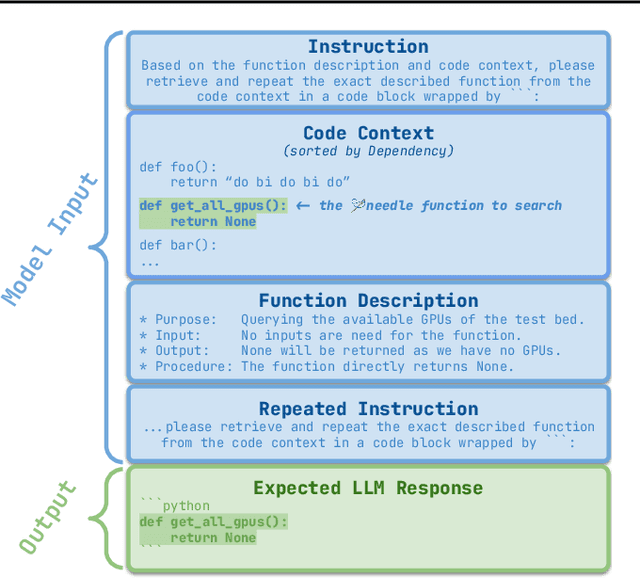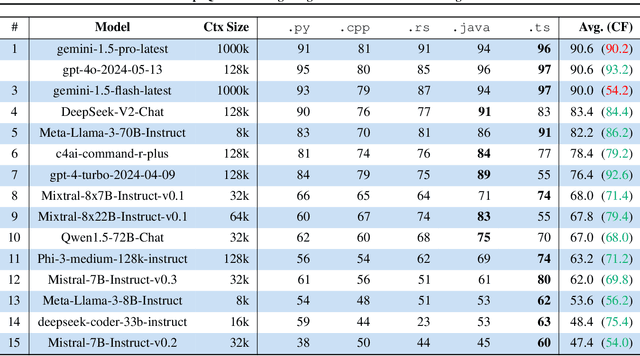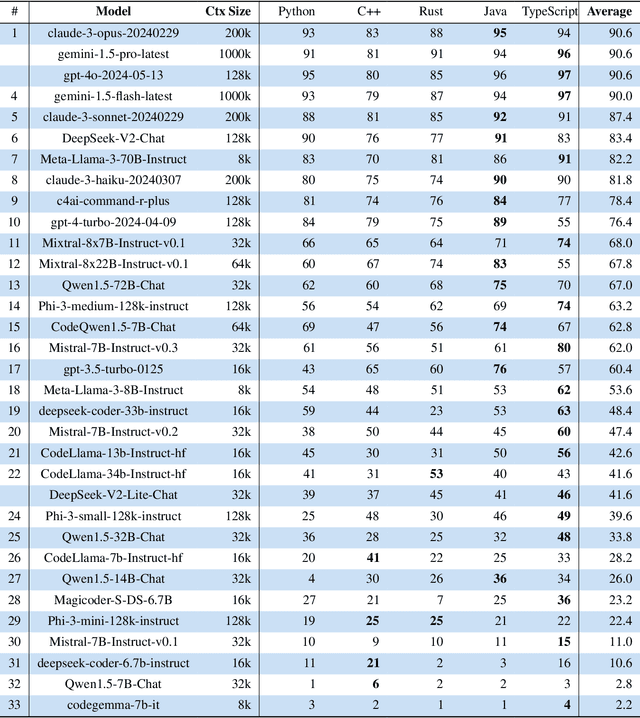Yifeng Ding
SMAR: Soft Modality-Aware Routing Strategy for MoE-based Multimodal Large Language Models Preserving Language Capabilities
Jun 06, 2025Abstract:Mixture of Experts (MoE) architectures have become a key approach for scaling large language models, with growing interest in extending them to multimodal tasks. Existing methods to build multimodal MoE models either incur high training costs or suffer from degraded language capabilities when adapting pretrained models. To address this, we propose Soft ModalityAware Routing (SMAR), a novel regularization technique that uses Kullback Leibler divergence to control routing probability distributions across modalities, encouraging expert specialization without modifying model architecture or heavily relying on textual data. Experiments on visual instruction tuning show that SMAR preserves language ability at 86.6% retention with only 2.5% pure text, outperforming baselines while maintaining strong multimodal performance. Our approach offers a practical and efficient solution to balance modality differentiation and language capabilities in multimodal MoE models.
SelfCodeAlign: Self-Alignment for Code Generation
Oct 31, 2024



Abstract:Instruction tuning is a supervised fine-tuning approach that significantly improves the ability of large language models (LLMs) to follow human instructions. We propose SelfCodeAlign, the first fully transparent and permissive pipeline for self-aligning code LLMs without extensive human annotations or distillation. SelfCodeAlign employs the same base model for inference throughout the data generation process. It first extracts diverse coding concepts from high-quality seed snippets to generate new tasks. It then samples multiple responses per task, pairs each with test cases, and validates them in a sandbox environment. Finally, passing examples are selected for instruction tuning. In our primary experiments, we use SelfCodeAlign with CodeQwen1.5-7B to generate a dataset of 74k instruction-response pairs. Finetuning on this dataset leads to a model that achieves a 67.1 pass@1 on HumanEval+, surpassing CodeLlama-70B-Instruct despite being ten times smaller. Across all benchmarks, this finetuned model consistently outperforms the original version trained with OctoPack, the previous state-of-the-art method for instruction tuning without human annotations or distillation. Additionally, we show that SelfCodeAlign is effective across LLMs of various sizes, from 3B to 33B, and that the base models can benefit more from alignment with their own data distribution. We further validate each component's effectiveness in our pipeline, showing that SelfCodeAlign outperforms both direct distillation from GPT-4o and leading GPT-3.5-based distillation methods, such as OSS-Instruct and Evol-Instruct. SelfCodeAlign has also led to the creation of StarCoder2-Instruct, the first fully transparent, permissively licensed, and self-aligned code LLM that achieves state-of-the-art coding performance.
Horizon-Length Prediction: Advancing Fill-in-the-Middle Capabilities for Code Generation with Lookahead Planning
Oct 04, 2024Abstract:Fill-in-the-Middle (FIM) has become integral to code language models, enabling generation of missing code given both left and right contexts. However, the current FIM training paradigm, which reorders original training sequences and then performs regular next-token prediction (NTP), often leads to models struggling to generate content that aligns smoothly with the surrounding context. Crucially, while existing works rely on rule-based post-processing to circumvent this weakness, such methods are not practically usable in open-domain code completion tasks as they depend on restrictive, dataset-specific assumptions (e.g., generating the same number of lines as in the ground truth). Moreover, model performance on FIM tasks deteriorates significantly without these unrealistic assumptions. We hypothesize that NTP alone is insufficient for models to learn effective planning conditioned on the distant right context, a critical factor for successful code infilling. To overcome this, we propose Horizon-Length Prediction (HLP), a novel training objective that teaches models to predict the number of remaining middle tokens (i.e., horizon length) at each step. HLP advances FIM with lookahead planning, enabling models to inherently learn infilling boundaries for arbitrary left and right contexts without relying on dataset-specific post-processing. Our evaluation across different models and sizes shows that HLP significantly improves FIM performance by up to 24% relatively on diverse benchmarks, across file-level and repository-level, and without resorting to unrealistic post-processing methods. Furthermore, the enhanced planning capability gained through HLP boosts model performance on code reasoning. Importantly, HLP only incurs negligible training overhead and no additional inference cost, ensuring its practicality for real-world scenarios.
Evaluating Language Models for Efficient Code Generation
Aug 12, 2024Abstract:We introduce Differential Performance Evaluation (DPE), a framework designed to reliably evaluate Large Language Models (LLMs) for efficient code generation. Traditional coding benchmarks often fail to provide reliable insights into code efficiency, due to their reliance on simplistic test inputs and the absence of effective compound metrics. DPE addresses these issues by focusing on efficiency-demanding programming tasks and establishing an insightful compound metric for performance evaluation. DPE operates in two phases: To curate efficiency datasets, it selects efficiency-demanding tasks from existing coding benchmarks and generates computationally expensive inputs to stress the efficiency of LLM solutions. To assess the code efficiency, DPE profiles the new solution and compares it globally against a set of reference solutions that exhibit distinct efficiency levels, where the matched level defines its efficiency score. As a proof of concept, we use DPE to create EvalPerf, a benchmark with 121 performance-challenging coding tasks. Our comprehensive evaluation draws interesting findings on the efficiency impact of model sizes, instruction tuning, and prompting. For example, while the scaling law fails to account for code efficiency, general instruction tuning benefits both code correctness and efficiency. We also evaluate the evaluation by examining the effectiveness of DPE, showing that EvalPerf is reliable and convenient to use even across platforms.
RepoQA: Evaluating Long Context Code Understanding
Jun 10, 2024


Abstract:Recent advances have been improving the context windows of Large Language Models (LLMs). To quantify the real long-context capabilities of LLMs, evaluators such as the popular Needle in a Haystack have been developed to test LLMs over a large chunk of raw texts. While effective, current evaluations overlook the insight of how LLMs work with long-context code, i.e., repositories. To this end, we initiate the RepoQA benchmark to evaluate LLMs on long-context code understanding. Traditional needle testers ask LLMs to directly retrieve the answer from the context without necessary deep understanding. In RepoQA, we built our initial task, namely Searching Needle Function (SNF), which exercises LLMs to search functions given their natural-language description, i.e., LLMs cannot find the desired function if they cannot understand the description and code. RepoQA is multilingual and comprehensive: it includes 500 code search tasks gathered from 50 popular repositories across 5 modern programming languages. By evaluating 26 general and code-specific LLMs on RepoQA, we show (i) there is still a small gap between the best open and proprietary models; (ii) different models are good at different languages; and (iii) models may understand code better without comments.
XFT: Unlocking the Power of Code Instruction Tuning by Simply Merging Upcycled Mixture-of-Experts
Apr 23, 2024



Abstract:We introduce XFT, a simple yet powerful training scheme, by simply merging upcycled Mixture-of-Experts (MoE) to unleash the performance limit of instruction-tuned code Large Language Models (LLMs). While vanilla sparse upcycling fails to improve instruction tuning, XFT introduces a shared expert mechanism with a novel routing weight normalization strategy into sparse upcycling, which significantly boosts instruction tuning. After fine-tuning the upcycled MoE model, XFT introduces a learnable model merging mechanism to compile the upcycled MoE model back to a dense model, achieving upcycled MoE-level performance with only dense-model compute. By applying XFT to a 1.3B model, we create a new state-of-the-art tiny code LLM (<3B) with 67.1 and 64.6 pass@1 on HumanEval and HumanEval+ respectively. With the same data and model architecture, XFT improves supervised fine-tuning (SFT) by 13% on HumanEval+, along with consistent improvements from 2% to 13% on MBPP+, MultiPL-E, and DS-1000, demonstrating its generalizability. XFT is fully orthogonal to existing techniques such as Evol-Instruct and OSS-Instruct, opening a new dimension for improving code instruction tuning. Codes are available at https://github.com/ise-uiuc/xft .
Magicoder: Source Code Is All You Need
Dec 04, 2023Abstract:We introduce Magicoder, a series of fully open-source (code, weights, and data) Large Language Models (LLMs) for code that significantly closes the gap with top code models while having no more than 7B parameters. Magicoder models are trained on 75K synthetic instruction data using OSS-Instruct, a novel approach to enlightening LLMs with open-source code snippets to generate high-quality instruction data for code. Our main motivation is to mitigate the inherent bias of the synthetic data generated by LLMs by empowering them with a wealth of open-source references for the production of more diverse, realistic, and controllable data. The orthogonality of OSS-Instruct and other data generation methods like Evol-Instruct further enables us to build an enhanced MagicoderS. Both Magicoder and MagicoderS substantially outperform state-of-the-art code models with similar or even larger sizes on a wide range of coding benchmarks, including Python text-to-code generation, multilingual coding, and data-science program completion. Notably, MagicoderS-CL-7B based on CodeLlama even surpasses the prominent ChatGPT on HumanEval+ (66.5 vs. 65.9 in pass@1). Overall, OSS-Instruct opens a new direction for low-bias and high-quality instruction tuning using abundant open-source references.
Exploring Driving Behavior for Autonomous Vehicles Based on Gramian Angular Field Vision Transformer
Oct 21, 2023Abstract:Effective classification of autonomous vehicle (AV) driving behavior emerges as a critical area for diagnosing AV operation faults, enhancing autonomous driving algorithms, and reducing accident rates. This paper presents the Gramian Angular Field Vision Transformer (GAF-ViT) model, designed to analyze AV driving behavior. The proposed GAF-ViT model consists of three key components: GAF Transformer Module, Channel Attention Module, and Multi-Channel ViT Module. These modules collectively convert representative sequences of multivariate behavior into multi-channel images and employ image recognition techniques for behavior classification. A channel attention mechanism is applied to multi-channel images to discern the impact of various driving behavior features. Experimental evaluation on the Waymo Open Dataset of trajectories demonstrates that the proposed model achieves state-of-the-art performance. Furthermore, an ablation study effectively substantiates the efficacy of individual modules within the model.
Revisiting the Plastic Surgery Hypothesis via Large Language Models
Mar 18, 2023Abstract:Automated Program Repair (APR) aspires to automatically generate patches for an input buggy program. Traditional APR tools typically focus on specific bug types and fixes through the use of templates, heuristics, and formal specifications. However, these techniques are limited in terms of the bug types and patch variety they can produce. As such, researchers have designed various learning-based APR tools with recent work focused on directly using Large Language Models (LLMs) for APR. While LLM-based APR tools are able to achieve state-of-the-art performance on many repair datasets, the LLMs used for direct repair are not fully aware of the project-specific information such as unique variable or method names. The plastic surgery hypothesis is a well-known insight for APR, which states that the code ingredients to fix the bug usually already exist within the same project. Traditional APR tools have largely leveraged the plastic surgery hypothesis by designing manual or heuristic-based approaches to exploit such existing code ingredients. However, as recent APR research starts focusing on LLM-based approaches, the plastic surgery hypothesis has been largely ignored. In this paper, we ask the following question: How useful is the plastic surgery hypothesis in the era of LLMs? Interestingly, LLM-based APR presents a unique opportunity to fully automate the plastic surgery hypothesis via fine-tuning and prompting. To this end, we propose FitRepair, which combines the direct usage of LLMs with two domain-specific fine-tuning strategies and one prompting strategy for more powerful APR. Our experiments on the widely studied Defects4j 1.2 and 2.0 datasets show that FitRepair fixes 89 and 44 bugs (substantially outperforming the best-performing baseline by 15 and 8), respectively, demonstrating a promising future of the plastic surgery hypothesis in the era of LLMs.
Establishing a stronger baseline for lightweight contrastive models
Dec 14, 2022



Abstract:Recent research has reported a performance degradation in self-supervised contrastive learning for specially designed efficient networks, such as MobileNet and EfficientNet. A common practice to address this problem is to introduce a pretrained contrastive teacher model and train the lightweight networks with distillation signals generated by the teacher. However, it is time and resource consuming to pretrain a teacher model when it is not available. In this work, we aim to establish a stronger baseline for lightweight contrastive models without using a pretrained teacher model. Specifically, we show that the optimal recipe for efficient models is different from that of larger models, and using the same training settings as ResNet50, as previous research does, is inappropriate. Additionally, we observe a common issu e in contrastive learning where either the positive or negative views can be noisy, and propose a smoothed version of InfoNCE loss to alleviate this problem. As a result, we successfully improve the linear evaluation results from 36.3\% to 62.3\% for MobileNet-V3-Large and from 42.2\% to 65.8\% for EfficientNet-B0 on ImageNet, closing the accuracy gap to ResNet50 with $5\times$ fewer parameters. We hope our research will facilitate the usage of lightweight contrastive models.
 Add to Chrome
Add to Chrome Add to Firefox
Add to Firefox Add to Edge
Add to Edge